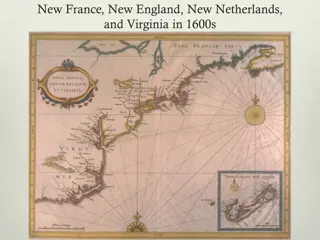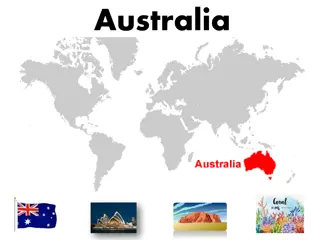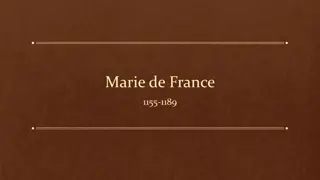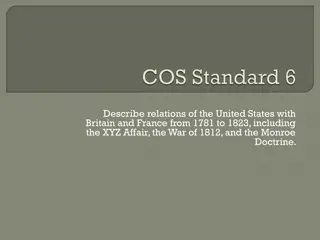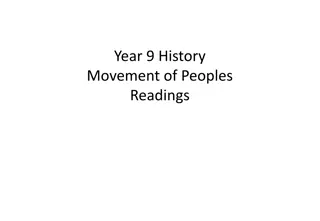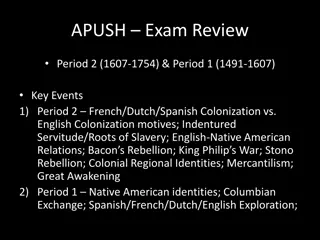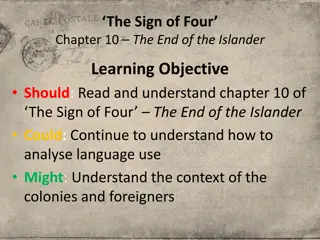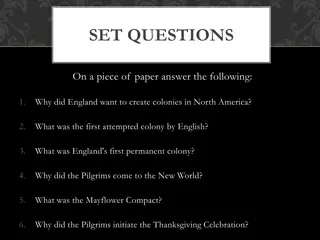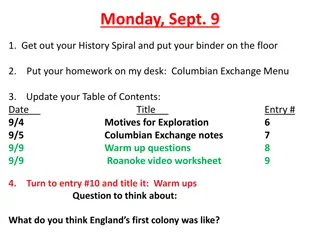The Duel for North America: France's Colonization Efforts
France, like England and Holland, was a latecomer in the race for North American colonies. King Louis XIV took an interest in overseas territories, leading to the establishment of Quebec in 1608. Samuel de Champlain played a key role in French colonization efforts, forging alliances with Native American tribes. The fur trade, particularly in beavers, was a significant economic driver for the French in North America. Antoine Cadillac founded Detroit to thwart English expansion, while efforts to halt Spanish influence led to the establishment of Louisiana. The Anglo-French conflicts during King William's War and Queen Anne's War reshaped territorial control in North America.
Download Presentation

Please find below an Image/Link to download the presentation.
The content on the website is provided AS IS for your information and personal use only. It may not be sold, licensed, or shared on other websites without obtaining consent from the author. Download presentation by click this link. If you encounter any issues during the download, it is possible that the publisher has removed the file from their server.
E N D
Presentation Transcript
Chapter 6 The Duel for North America
France Begins to Colonize Like England and Holland, France was a latecomer in the race for colonies. It was convulsed in the 1500s by foreign wars and domestic strife. In 1598, the Edict of Nantes was issued, allowing limited toleration to the French Huguenots. When King Louis XIV became king, he took an interest in overseas colonies. In 1608, France established Quebec, overlooking the St. Lawrence River. Unlike English colonists, French colonists didn t immigrate to North America by hordes. The peasants were too poor, and the Huguenots weren t allowed to leave.
Samuel De Champlain Intrepid soldier and explorer Father of New France. He entered into friendly relations with the neighboring Huron Indians and helped them defeat the Iroquois. The Iroquois, however, did hamper French efforts into the Ohio Valley later.
Most valuable commodity was the beaver Coureurs de bois (runners of the woods - Beaver hunters Littered the land with place names, including Baton Rouge (red stick), Terre Haute (high land), Des Moines (some monks) and Grand Teton (big breasts). Recruited Indians to hunt for beaver Indians were decimated by the white man s diseases beaver population was heavily extinguished. French Catholic missionaries zealously tried to convert Indians. New France (Canada)
To thwart English settlers from pushing into the Ohio Valley, Antoine Cadillac founded Detroit ( city of straits ) in 1701. Louisiana was founded, in 1682, by Robert de LaSalle, to halt Spanish expansion into the area near the Gulf of Mexico. Three years later, he tried to fulfill his dreams by returning, but instead landed in Spanish Texas and was murdered by his mutinous men in 1687. The fertile Illinois country, where the French established forts and trading posts at Kaskaskia, Cahokia, and Vincennes, became the garden of France s North American empire.
King Williams War and Queen Annes War The English colonists fought the French coureurs de bois and their Indian allies. Neither side considered America important enough to waste real troops. The French-inspired Indians ravaged Schenectady, NY, and Deerfield, Mass. The British did try to capture Quebec and Montreal, failed, but did temporarily have Port Royal. The peace deal in Utrecht in 1713 gave Acadia (renamed Nova Scotia), Newfoundland, and Hudson Bay to England, pinching the French settlements by the St. Lawrence. It also gave Britain limited trading rights with Spanish America.
War of Jenkins Ear An English Captain named Jenkins had his ear cut off by a Spanish commander, who had essentially sneered at him to go home crying. This war was confined to the Caribbean Sea and Georgia. This war soon merged with the War of Austrian Succession and came to be called King George s War in America. France allied itself with Spain, but England s troops captured the reputed impregnable fortress of Cape Breton Island (Fort Louisbourg). However, peace terms of this war gave strategically located Louisbourg, which the New Englanders had captured, back to France, outraging the colonists, who feared the fort.
George Washington Starts a War The Ohio Valley became a battleground among the Spanish, British, and French. It was lush, fertile, and very good land. In 1754, the governor of Virginia sent 21 year-old George Washington to the Ohio country as a lieutenant colonel in command of about 150 Virginia minutemen. Encountering some Frenchmen in the forest about 40 miles from Fort Duquesne, the troops opened fire, killing the French leader. Later, the French returned and surrounded Washington s hastily constructed Fort Necessity, fought Indian style (hiding and guerilla fighting), and after a 10-hour siege, made him surrender. He was permitted to march his men away with the full honors of war.
French and Indian War The fourth of these wars between empires started in America, unlike the first three. The French and Indian War (AKA Seven Years War) began with Washington s battle with the French. It was England and Prussia vs. France, Spain, Austria, and Russia. In Germany (Prussia), Fredrick the Great won his title of Great by repelling French, Austrian, and Russian armies, even though he was badly outnumbered.
Albany Congress Many Americans sought for the American colonies to unite, for strength lay in numbers. In 1754, 7 of the 13 colonies met for an inter-colonial congress held in Albany, New York. A month before the congress, Ben Franklin had published his famous Join or Die cartoon featuring a snake in pieces, symbolizing the colonies. Franklin helped unite the colonists in Albany, but the Albany plan failed because the states were reluctant to give up their sovereignty or power. Still, it was a first step toward unity.
General Braddock In the beginning, the British sent haughty 60 year-old Gen. Edward Braddock to lead a bunch of inexperienced soldiers with slow, heavy artillery. In a battle with the French, the British were ambushed routed by French using Indian-tactics. In this battle, Washington reportedly had two horses shot from under him and four bullets go through his coat, but never through him. Afterwards, the frontier from Pennsylvania to North Carolina felt the Indian wrath, as scalping occurred everywhere. As the British tried to attack a bunch of strategic wilderness posts, defeat after defeat piled up.
William Pitt In this hour of British trouble, William Pitt, the Great Commoner, took the lead. In 1757, he became a foremost leader in the London government and later earned the title of Organizer of Victory Changes Pitt made He soft-pedaled assaults on the French West Indies, assaults which sapped British strength, and concentrated on Quebec-Montreal (since they controlled the supply routes to New France). He replaced old, cautious officers with younger, daring officers
In 1758, Louisbourg fell. This root of a fort began to wither the New France vine since supplies dwindled. 32 year-old James Wolfe, dashing and attentive to detail, commanded an army that boldly scaled the cliff walls of a part protecting Quebec, met French troops near the Plains of Abraham, and in a battle in which he and French commander Marquis de Montcalm both died, the French were defeated and the city of Quebec surrendered. The 1759 Battle of Quebec ranks as one of the most significant engagements in British and American history, and when Montreal fell in 1760, that was the last time French flags would fly on American soil.
Treaty of Paris 1763 In the Peace Treaty at Paris in 1763 France was totally kicked out of North America. This meant the British got Canada and the land all the way to the Mississippi River. The French were allowed to retain several small but valuable sugar islands in the West Indies and two never-to- be-fortified islets in the Gulf of St. Lawrence for fishing stations. France s final blow came when they gave Louisiana to Spain to compensate for Spain s losses in the war. Great Britain took its place as the leading naval power in the world, and a great power in North America.
Aftermath of the War The colonists, having experienced war firsthand and come out victors, were very confident. The myth of British invincibility had been shattered. Friction between the British officers and the colonial boors. British refused to recognize any American officers above the rank of captain. Hardworking Americans believed that they were equals with the Redcoats Brits were concerned about American secret trade with enemy traders during the war Last year of the war, the British forbade the export of all supplies from New England to the middle colonies. Many American colonials refused to help fight the French until Pitt offered to reimburse them. Led to more colonial unity During the War Americans from different parts of the colonies found, surprisingly to them, that they had a lot in common (language, tradition, ideals) and barriers of disunity began to melt.
New Geography for the Colonists Now that the French had been beaten, the colonists could now roam freely, and were less dependent upon Great Britain. The French consoled themselves with the thought that if they could lose such a great empire, maybe the British would one day lose theirs too. Spain was eliminated from Florida, and the Indians could no longer play the European powers against each other, since it was only Great Britain in control now.
Chief Pontiac In 1763, Ottawa Chief Pontiac led a few French- allied tribes in a brief but bloody campaign through the Ohio Valley, but the whites quickly and cruelly retaliated after being caught off guard. One commander ordered blankets infected with smallpox to be distributed. The violence convinced whites to station troops along the frontier.
Proclamation of 1763 could now settle west of the Appalachians Parliament issued the Proclamation of 1763, prohibiting any settlement west of the Appalachians. Was supposed to fix the Indian problem by drawing the out-of-bounds line Colonists saw it as another form of oppression from a far away country. Americans asked, Didn t we just fight a war to win that land? In 1765, an estimated one thousand wagons rolled through the town of Salisbury, North Carolina, on their way up west in defiance of the Proclamation. The British, proud and haughty, were in no way to accept this blatant disobedience by the lowly Americans, and the stage was set for the Revolutionary War. Land-hungry Americans




